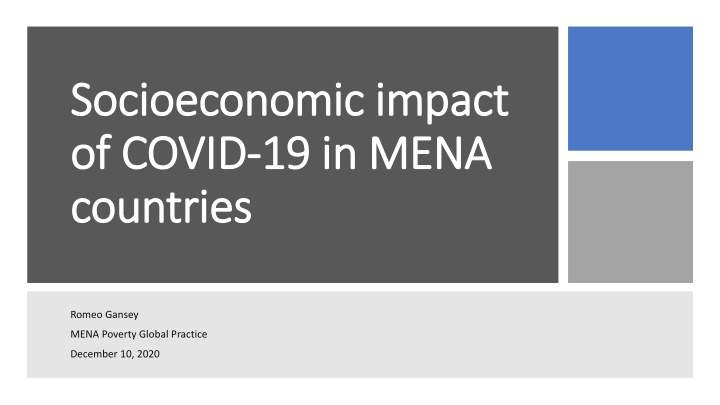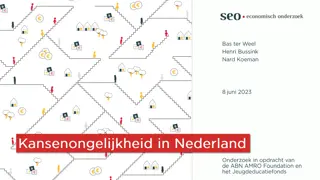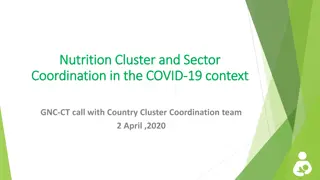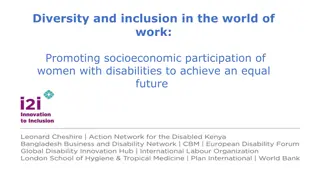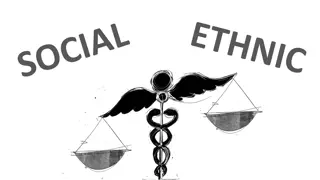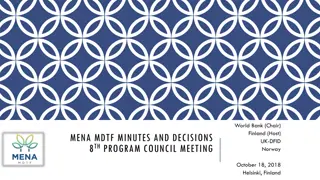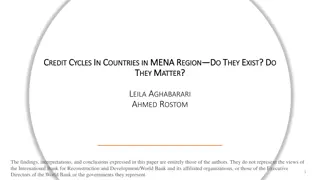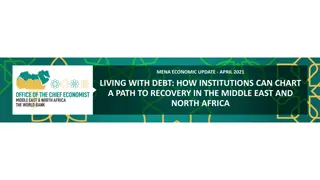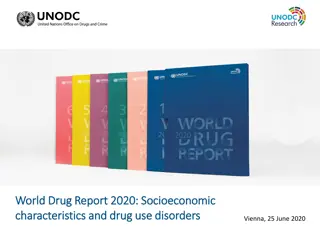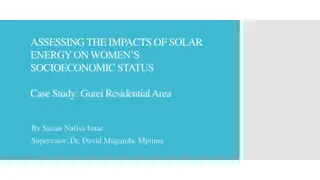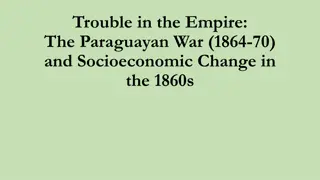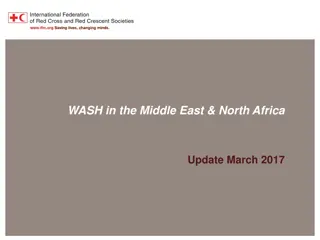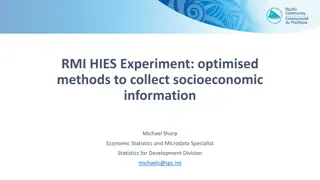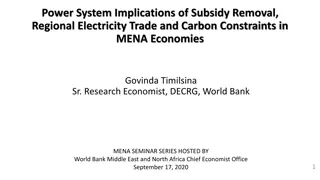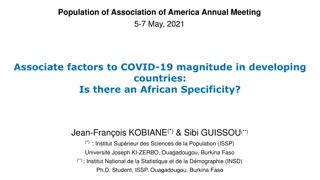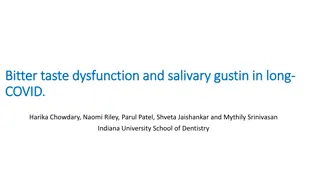Socioeconomic Impact of COVID-19 in MENA Countries
This information discusses the socioeconomic impact of COVID-19 in the MENA region, focusing on poverty, earnings, food insecurity, access to services, and social protection. It examines the increase in the number of poor people and microsimulations from Jordan showing higher poverty impacts. The pandemic's translation into welfare deterioration is highlighted, along with the advantages and disadvantages of COVID phone surveys in the region.
Download Presentation

Please find below an Image/Link to download the presentation.
The content on the website is provided AS IS for your information and personal use only. It may not be sold, licensed, or shared on other websites without obtaining consent from the author.If you encounter any issues during the download, it is possible that the publisher has removed the file from their server.
You are allowed to download the files provided on this website for personal or commercial use, subject to the condition that they are used lawfully. All files are the property of their respective owners.
The content on the website is provided AS IS for your information and personal use only. It may not be sold, licensed, or shared on other websites without obtaining consent from the author.
E N D
Presentation Transcript
Socioeconomic impact Socioeconomic impact of COVID of COVID- -19 in MENA 19 in MENA countries countries Romeo Gansey MENA Poverty Global Practice December 10, 2020
COVID and Poverty: what we knew COVID phone surveys in the MENA Region What are we learning from the COVID phone surveys? COVID and ability to work COVID and earnings Food insecurity Access to services Social protection and adaptive household responses What can we say about the new poor? Are the COVID induced impacts short-lived? Outline Outline
COVID and Poverty: what we knew
Impact COVID on the Number of Poor People Impact COVID on the Number of Poor People in the MENA Region (at $5.5 poverty line) in the MENA Region (at $5.5 poverty line) 250 200 Million people 150 23 million New poor 100 50 0 2011 2012 2013 2015 2018 2019 2020 2021 Pre-COVID projection Baseline projection, September 2020 Source: World Bank staff calculations and PovcalNet (online analysis tool), World Bank, Washington, DC
Microsimulations from Jordan suggest higher poverty impacts an example 30 29.9 Poverty headcount 25 20 15.4 percent 15 15.3 14.1 10 5 0 + After all social assistance Income shock Counterfactual Source: World Bank, Jordan Emergency Cash Transfer Covid-19 Response Project
How does the pandemic translate into welfare deterioration? Source: World Bank, Jordan Emergency Cash Transfer Covid-19 Response Project
COVID phone surveys fielded in the MENA Region
Disadvantages Few questions Avoidance interesting but sensitive questions (i.e., intimate partner violence) Need to keep sample relatively small - sometimes a threat to representativeness Advantages Rapidity and flexibility Feasibility (only option during lockdown) Opportunity to collaborate with NSOs and bring about innovation in data collection (which is expected to outlast the COVID pandemic) Phone surveys: Pro s and Con s in COVID times
Phone surveys in the MENA region Surveys Sample size Response rate Percentage female breadwinner Implementing agency Djibouti (2 waves) 2,082 71% 28% National Statistical Office Egypt 2,034 57% 10% Baseera (Egyptian Center for Public Opinion Iraq (2 waves) 1,621 Not Reported Not Reported World Food Program Jordan In preparation Libya 530 Not Reported Not Reported World Food Program Morocco 2,350 Not Reported Not Reported Higher Planning Commission Palestine 8,709 88% 6% National Statistical Office Saudi Arabia In preparation Tunisia (5 waves) 1,360 77% Not Reported National Statistical Office Yemen 4,287 Not Reported Not Reported World Food Program
Surveys were fielded toward the end of lockdown or weeks after
Topics covered in phone surveys Labor market Sources of income Access to basic goods and services Food insecurity Social protection and safety nets BUT not all countries have all pieces of information
Crosstabulations Analytical approach Partial correlations (logistic regressions) Parsimonious reduced forms (logistic regressions)
What are we learning from the COVID phone surveys?
100 A large fraction A large fraction stopped stopped working during working during lockdown, but lockdown, but fewer did so fewer did so weeks after weeks after 12 19 90 22 36 80 16 70 19 41 60 50 41 40 64 30 59 47 20 23 10 0 Djibouti Egypt Palestine Tunisia Worked Stopped working Inactive
Log-odds ratios base: bottom quintile 1.0 0.5 Heterogenous: Heterogenous: higher quintile less higher quintile less likely to stop likely to stop working working 0.0 -0.5 -1.0 -1.5 -2.0 3rd 3rd 4th 3rd 4th 4th Top Top 2nd quintile 2nd quintile 2nd quintile Djibouti (5th quintile not covered) Egypt Tunisia
Log-odds ratios base: agriculture 4.5 3.5 2.5 Work stoppage: Work stoppage: Construction Construction workers hard hit workers hard hit 1.5 0.5 -0.5 -1.5 -2.5 Services Services Services Other ind. Other ind. Other ind. Construction Construction Construction Public Admin. Public Admin. Palestine Egypt Tunisia
2.00 Log-odds ratios bases: male; rural 1.50 1.00 Work stoppage: large Work stoppage: large and rural households and rural households at higher risks at higher risks 0.50 0.00 -0.50 -1.00 -1.50 -2.00 log(HH size) Femalelog(HH Urban log(HH Female Urban Camp log(HH Urban size) size) size) Djibouti Egypt Palestine Tunisia
100% Notable Notable transitions in transitions in employment employment status status between between survey waves survey waves 90% 25 80% 70% 67 60% 82 82 50% 40% 75 30% 20% 33 10% 18 18 0% Did not Work -- wave 1 Worked week before wave 1 Did not Work -- wave 1 Worked week before wave 1 Djibouti Tunisia Did not Work -- wave 2 Worked week before wave 2
100 4 3 90 16 Impact on Impact on labor also at labor also at intensive intensive margins margins 80 70 54 60 50 80 40 30 42 20 10 0 Djibouti Palestine Less than usual As usual More than usual
100 5 90 10 22 23 Working less Working less is associated is associated with loss of with loss of income income 29 80 15 70 38 10 25 60 50 40 63 30 60 52 47 20 10 0 Djibouti Palestine Tunisia Yemen No Pay Partial wage Full wage Don t Know/Refused
2.0 Log-odds ratios base: bottom quintile 1.5 Income loss: Income loss: heterogenous heterogenous impact by wealth impact by wealth status (only in status (only in Tunisia) Tunisia) 1.0 0.5 0.0 -0.5 -1.0 -1.5 -2.0 -2.5 -3.0 -3.5 2nd quintile 3rd 4th 2nd 3rd 4th Top Djibouti (5th quintile not covered) Tunisia
Experience of food insecurity (%) Experience of food insecurity (%) Djibouti Palestine 49 Worried about food Worried about food 61 49 Ate only a few kinds of food Ate only a few kinds of foods 57 49 Unable to eat preferred food Unable to eat healthy food 46 39 Ate food they really do not want 33 Skipped a meal 41 Ate a smaller meal 14 Ate fewer meals Ate a smaller meal 38 10 Had no food of any kind Ran out of food 18 6 Experienced going to sleep hungry Hungry but did not eat 8 4 Whole day without food Whole day without eating 6 0 10 20 30 40 50 60 Poor Non-poor 0 10 20 30 40 50 60 70
50 Experience-based scale of food insecurity in Palestine (%) 43 45 High level of High level of food food insecurity insecurity 40 37 34 35 30 25 23 20 15 10 5 3 2 2 1 0 Palestine Urban Rural Camp Moderate+severe Severe
Log-odds ratios base: bottom quintile 0.0 -0.5 More stress about More stress about food insecurity food insecurity among lower among lower quintiles quintiles -1.0 -1.5 -2.0 -2.5 -3.0 2nd 3rd 4th Top Tunisia
Food insecurity is less likely among Food insecurity is less likely among households whose breadwinners worked households whose breadwinners worked Table 1a: log-odds ratios of a series of regressions of various items of food insecurity on the ability to work controlling for socio-demographic characteristics - Djibouti (1) Worry about food on food quality Characteristics Worried Ate few kinds Table 1.b: log-odds ratios of regressing various items of food insecurity on the ability to works controlling for demographic characteristics - Palestine (2) (3) (4) (5) (1) Worry about food Worried Ate few kinds (2) Compromise on food quality (3) Compromise on food quantity (4) (5) Compromise Compromise on food quantity Ate Skipped meal Runout of food Characteristics Ate Skipped meal Runout of of food smaller meal of food smaller meal food Worked (Yes=1) Log household size Poor (Yes=1) Constant N Robust standard errors in brackets *** p<0.01, ** p<0.05, * p<0.1 -1.03*** 0.27** 0.33** -1.16*** 0.40*** -0.56*** -0.48** -0.27* -0.62*** 0.19 Yes 1,460 -0.51* Worked (Yes=1) Log household size [Base category = Rural] Urban Camp Constant N Robust standard errors in brackets *** p<0.01, ** p<0.05, * p<0.1 -0.48*** 0.75*** -0.55*** 0.84*** -0.73*** -0.74*** -0.72*** 0.77*** 0.84*** 0.12 0.23 Yes 1,460 0.57*** 0.17 Yes 1,460 0.57** Yes Yes 1,460 1,460 0.17 0.34* Yes 8,363 0.55*** 0.39** 0.40*** 0.67*** 0.41*** 0.58*** 0.41** 0.54** Yes Yes Yes Yes 8,363 8,363 8,363 8,363
100 96 90 Low access to Low access to health in many health in many countries countries 80 68 70 63 63 60 55 52 50 40 30 20 10 0 Morocco Yemen Djibouti Tunisia Iraq Palestine
2.5 Log-odds ratios base: bottom quintile 2.0 1.5 Little difference in Little difference in access to healthcare access to healthcare across income groups across income groups 1.0 0.5 0.0 -0.5 -1.0 -1.5 2nd quintile 3rd 4th 2nd 3rd 4th Top Djibouti (5th quintile not covered) Tunisia
Low coverage of cash transfers (%) 30 25 25 22 20 17 15 10 9 8 10 7 5 5 5 4 3 5 2 0 All Poor Non-poor Bottom 2 3 4 Top Bottom quintile 2 3 4 Top quintile quintile quintile Palestine Djibouti Egypt Tunisia
Exceptionally high coverage of fo Exceptionally high coverage of food stamp programs in Egypt, but low stamp programs in Egypt, but low everywhere else everywhere else od 100 90 89 89 89 90 80 72 70 60 50 40 30 28 24 30 22 20 8 6 5 4 10 2 1 0 All Bottom 2 3 4 Bottom 2 3 4 Top Bottom 2 3 4 Top Palestine Djibouti (5th quintile not covered) Egypt Tunisia
In Iraq, In Iraq, more recipients of public transfers after more recipients of public transfers after lockdown lockdown Percentage receiving public transfers February (Pre-lockdown) Percentage receiving public transfers - July 100% 100% 0 0 0 0 0 0 0 0 0 0 90% 90% 80% 80% 70% 70% 60% 60% 83 83 86 88 89 89 90 90 90 95 50% 50% 40% 40% 30% 30% 20% 20% 10% 10% 17 17 14 12 11 11 10 10 10 5 0% 0% KRI North Center South Iraq KRI North Center South Iraq Yes No Don t know/refused Yes No Don't know/refused
Who should be targeted for social safety nets in the future? Table 2: log-odds ratios of indicators of food insecurity on reception of public assistance, pooled sample (Djibouti, Palestine, and Tunisia) Panel A Worried about food [Base category: Stopped working*Received some aid] Worked*Received no aid -1.595*** -1.111*** Panel B Ate less Worried about food Ate less [Base category: Received no wage*Received some aid] Received some wage*Received no aid Received wage*Received some aid Received no wage*Received no aid -1.453*** -1.430*** Worked*Received some aid Stopped working*Received no aid Logged household size [Base category: Tunisia] Djibouti Palestine Constant -0.452 -0.768** -0.288 -0.17 0.059 0.212 -1.210** 0.563 0.919*** 0.834*** Logged household size [Base category: Tunisia] Djibouti Palestine 0.716 0.621 NA 0.632*** 1.450*** 2.353*** Yes NA 0.603** 0.875*** 1.742*** Yes Yes Yes N Robust standard errors in brackets *** p<0.01, ** p<0.05, * p<0.1 Note: NA=Not available 9,736 11,222 3,580 3,940
30 25 25 Selected Selected household household adaptive adaptive strategies strategies 25 22 20 Percent 14 15 10 5 0 Savings Assistance from friends Savings Assistance from friends Tunisia Morocco
What can we say about the new poor?
Job loss will push many into poverty as: savings are low across all income groups public transfers are not often geared toward the well to do Therefore Households from bottom quintile will become poorer Most of new poor will likely be concentrated among workers from higher quintiles who lost their jobs in : construction sector and services sector Profile of the new poor a heuristic approach
Are the COVID induced impacts short-lived?
Signs of recovery with pace similar by poverty Signs of recovery with pace similar by poverty status, but there status, but there might be some might be some scarring .. scarring .. 70 85 66 64 78 64 80 77 77 60 56 75 50 70 40 65 37 62 59 59 60 30 25 55 20 50 10 45 0 40 Pre COVID (2019) During lockdown Lockdown + 2 weeks Lockdown + 5 weeks Lockdown +7 weeks Lockdown + 20 weeks Lockdown + 8 weeks Lockdown + 16 weeks Tunisia Bottom 20 Upper 80 Djibouti Poor Non-poor
100% 18 19 19 90% Slower pace Slower pace of recovery in of recovery in Iraq Iraq 80% 7 19 20 70% 60% 50% 40% 75 62 30% 60 20% 10% 0% Before lockdown August September Working Not working but seeking work Did not have any job and not seeking
Djibouti But faster But faster improvement improvement in earnings in earnings among the among the non non- -poor poor compared with compared with the poor the poor Wave 2 45 44 5 6 Poor Wave 1 49 32 13 7 Non-poor Wave 2 34 51 5 10 Wave 1 45 37 9 8 National Wave 2 35 50 5 9 Wave 1 46 37 10 8 0% 20% 40% 60% 80% 100% Received no pay Received partial pay Received full payment Refusal/Don't know
Everywhere, the lockdown forced many to stop working. Most of those who were still working saw a sharp decline in their incomes. The most vulnerable are bearing a larger burden of the economic fallouts of the crisis: households from the lower quintiles and from rural areas are more likely to suffer job losses and reduction in incomes. Food insecurity remains high in the region, with the poor at higher risk. The ability to work is negatively associated with the experience of food insecurity. Public transfers have been critical in helping households contend with the fallouts of the crisis, yet they are insufficient. New households are crossing the poor threshold; but the traditionally poor would now be much poorer. New poor most likely to be concentrated in the construction and services sector. The ability to work tends to improve over time, after lockdown was lifted; but the poor are still facing reduced earnings even if they managed to work. Main highlights
Moving forward What directions for further research can be gleaned? Comments and suggesting are very much welcomed.
We express our profound gratitude to Hans Hoogeveen for his kind supervision. We thank the Jordan poverty team for sharing their results. We further thank all the colleagues from the MENA Poverty GP and DERCG for their contributions and comments. Acknowledgements Acknowledgements
